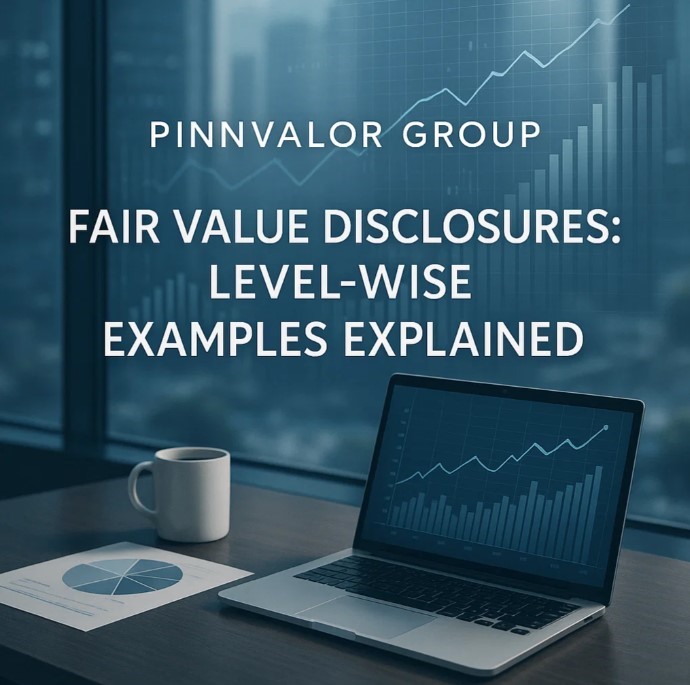
Fair Value Disclosures: Level-Wise Examples Explained
Fair value measurement is a cornerstone of modern financial reporting. It provides stakeholders with a clear picture of the current value of a company’s assets and liabilities, rather than just the historical cost. The International Financial Reporting Standards (IFRS 13) and US GAAP mandate that entities disclose fair value information in their financial statements, including level-wise classification.
In this blog, we break down the concept of fair value disclosures and provide practical level-wise examples to help you understand how organizations report these measurements.
Do you really know how companies value their assets and liabilities in today’s market?What truly makes a Bitcoin worth thousands—or a digital ape worth millions?
Fair value disclosures reveal the true worth of assets and liabilities, giving investors the clarity they deserve.
What is Fair Value?
Fair value is defined as the price that would be received to sell an asset or paid to transfer a liability in an orderly transaction between market participants at the measurement date. Unlike historical cost, fair value reflects current market conditions, providing a more realistic view of a company’s financial position.
Fair value disclosures are important because they:
- Improve transparency in financial reporting.
- Help investors, analysts, and regulators assess the true value of assets and liabilities.
- Facilitate informed decision-making.
The Fair Value Hierarchy
The fair value hierarchy classifies inputs used to measure fair value into three levels:
- Level 1: Quoted prices in active markets for identical assets or liabilities.
- Level 2: Observable inputs other than quoted prices included in Level 1, such as quoted prices for similar assets or other market data.
- Level 3: Unobservable inputs based on the entity’s assumptions about market participant assumptions.
Each level reflects the reliability and observability of the inputs used in determining fair value.
Level-Wise Examples of Fair Value Disclosures
Level 1: Quoted Prices in Active Markets
Level 1 inputs are considered the most reliable because they come from observable market prices for identical assets or liabilities.
Examples:
- Listed equity shares (e.g., Apple Inc. shares traded on NASDAQ)
- Government bonds traded in active markets
- Exchange-traded derivatives (e.g., futures, options)
Disclosure Example:
Financial Assets at Fair Value (Level 1): - Equity shares of XYZ Ltd.: $1,500,000 - Government bonds: $800,000
Level 2: Observable Inputs Other Than Level 1
Level 2 inputs are based on observable market data, either directly or indirectly. They are not as straightforward as Level 1 but still reasonably reliable.
Examples:
- Corporate bonds not actively traded, valued using quoted prices of similar bonds
- Interest rate swaps or other over-the-counter derivatives priced using market-observable inputs
- Property valued using market comparables
Disclosure Example:
Financial Assets at Fair Value (Level 2): - Corporate bonds: $1,200,000 (valued using similar bond yields) - Interest rate swap: $300,000 (based on observable market rates)

Level 3: Unobservable Inputs
Level 3 inputs are used when observable data is not available. These rely on management’s judgment and assumptions about market conditions.
Examples:
- Private equity investments
- Complex derivatives with no active market
- Real estate properties in illiquid markets
Disclosure Example:
Financial Assets at Fair Value (Level 3): - Private equity investment: $500,000 (valued using discounted cash flow model) - Investment property: $2,000,000 (based on internal appraisal)
Key Points for Fair Value Disclosures
- Transparency: Companies must explain the valuation techniques used for each level.
- Reconciliation: Level 3 assets often require reconciliation showing opening balance, purchases, sales, gains/losses, and ending balance.
- Sensitivity Analysis: Disclose how changes in assumptions affect fair value for Level 3 assets.
- Segregation by Level: Clearly categorize assets and liabilities into Level 1, 2, or 3 for comparability.
Conclusion
Fair value disclosures enhance the quality of financial reporting by providing a clear, market-based view of assets and liabilities. Understanding the level-wise classification helps stakeholders assess the reliability of the reported values. While Level 1 is the most straightforward, Level 2 and Level 3 require careful valuation techniques and detailed disclosure.
By using practical examples, companies can improve transparency and build trust with investors and regulators. For finance professionals, mastering fair value disclosures is essential to delivering accurate and insightful financial statements.